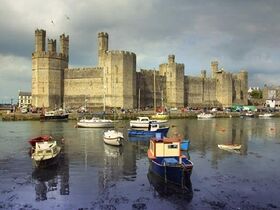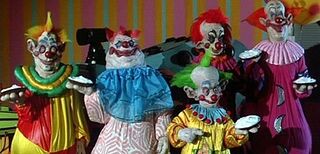Caernarfon
Caernarfon (known to locals as Cuhnahvun yeh) is a town in north Wales, situated somewhere in county Gwynedd. Despite having the size, population and crime level of a city, it is classified as a "town" for some reason. The town's English equivalent is considered to be Liverpool, though seaside town Rhyl has also contended for said title. Since Rhyl folk actually have Scouse accents, Caernarfon has sometimes been compared to Manchester, though any English town will do as they are all the same. Known to most Welsh people as "the town we'd like to forget exists", Caernarfon's notorious reputation as the epitome for everything wrong with Wales makes one wonder as to why English invaders were so desperate to claim it as their own.
Etymology[edit]
Nobody really knows where the name "Caernarfon" or "Carnarvon" came from, nor does anyone care, really. As a result, no linguist has bothered in seriously finding out what the name "Caernarfon" means, though they all unanimously agree that whatever the origin is, it is undoubtedly a sinister one.
History[edit]
Though the area was inhabited prior, present-day Caernarfon was officially founded in the 13th century by King Edward I of England when he built a castle there; although after his carriage was broken into and robbed (when he turned his back for a second), the King was scared witless by such barbaric acts and left. When Welsh rebel Owain Glyndŵr fought back against England in the 15th century, the people of Caernarfon were afraid of being caught in the ongoing battle. They walled themselves up and isolated themselves from the outside world for over 400 years.
In the 19th century, the walls came down, but thanks to years of isolation not only were its inhabitants severely inbred and looking like slightly handsome pitbulls, their language had evolved from Welsh to a butchered dialect of ghetto-esque slang. The new English concept of "crime", which was not present in the paradise of Wales before the arrival of the English, was by now widespread in Caernarfon. To this day, it is the second-most crime filled city in Wales, beaten only by Rhyl, a town that most Welsh people will refuse to even class as "Welsh".
Culture[edit]
Caernarfon in recent years has received the attention of tourists after being featured in various bits of pop culture, such as the 2002 S4C documentary "Ar Y Stryd" ("on the street"), a documentary about homeless drug addicts, portraying the city as rampant with such problems. Homeless drug addicts from all over Britain flocked to Caernarfon, finding it to be a place where they could fit in. It was also featured in the book Tisio Bet, literally meaning "Do you wish to place a wager?" (or simply "Want to Bet"), and while it does not feature drug addicts, the well-written story revolves around a group of 13 year olds gambling, slashing tyres, drinking vodka, stealing clothes and beating each other senseless - typical hobbies enjoyed by youths of the town. It is endlessly studied by Welsh schools who have considered the story as the Welsh form of Shakespeare, not because of its literary value, but because they have to stop every 3 minutes to translate it.
Caernarfon's town council is one of the most efficient in Wales. Having decided that democracy is a flawed and, quite frankly, far too delayed process, they have settled on their own way of solving the numerous issues that a large town will come across; the biggest member gets his say, and anyone who disagrees may challenge his dominance through a physical debate.
Slang[edit]
Caernarfon's unique slang accurately matches its drug and alcohol industry as cheap and excessive. Because heroin, cheap lager and very close families are so widespread, their population have developed their own unique way of communicating efficiently, as classic Welsh was becoming a nuisance to pronounce. Examples of Caernarfon speak are as follows:
- Lwmp o: pronoun, "lump of" (used to exaggerate; ask a dealer for a lump of pure heroin for a fun time)
- Jaman: noun, means "disappointment" (to expect pure heroin, and get a cheap substitute, is considered a "jaman")
- Sleifar: adjective, "nice" (if you see an expensive car in the street and wish to steal it, you would call it a "sleifar" of a car)
- Lysh: noun, alcohol (if you wish to buy beer from an off-license using a fake ID card, ask for "lush")
Landmarks[edit]
Caernarfon is home to a few well-known landmarks, recognisable to anyone who lives within 3 feet of the town. The most notable of these is Caernarfon castle, which is a castle. It was built by the English king Edward Longshanks while he was "occupying" the territory (Englishmen don't like people saying they "invaded" Wales). Caernarfon is also well known for its local pub, Lysh Jaman, which as well as beer and cider serves a variety of hard heroin, crack, tobacco, speed and Walkers crisps.
Caernarfon mountain is the 14th tallest mountain in Wales, and has existed since the 1960s. The mountain itself is made up of a giant pile of rubbish and litter, covered in strips of bin bag and black foil. Environmental groups have in the past demanded the polluting litter pile removed, but the people of Caernarfon insist that their mountain should not go, as it is now part of the Caernarfon spirit, and that its smell is an improvement on the old Caernarfon smell.
See Also[edit]
- Cunt (affectionate term the population use to refer to their friends)
- Beavis and Butthead (celebrity duo hailing from here)
- Grand Theft Auto: Caernarfon (popular video game set in Caernarfon)




